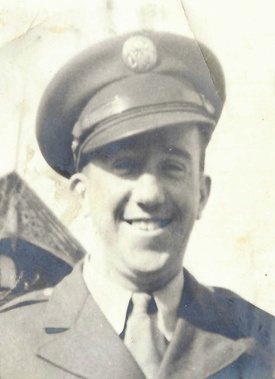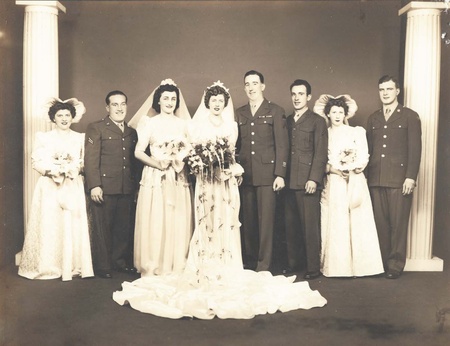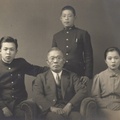Former President Trump’s rants against the “Kung Flu” or “Chinese Flu” contributed to a rash of anti-Asian hate crimes across the country recently, which has distressed and greatly affected the Asian American community. Unfortunately, this is not a new set of circumstances. Anti-Asian sentiment and laws have existed for over a hundred years in America. Sometimes it is difficult to understand where this enmity against Asian people comes from, especially for those living in Hawai‘i, where different ethnic groups live together in relative harmony.
This story speaks to a different time in our nation’s history when our military was racially segregated. Still, some unlikely friendships were forged in the heat of battle and destruction of war.
An Unusual Request
A few months ago, the Nisei Veterans Legacy received an interesting request from one of our sister organizations on the U.S. mainland about a gentleman named Carmine Iosue (pronounced “eye-oh-sue”) from Chicago who was interested in meeting members of the Nisei-veterans community here on O‘ahu.
The email mentioned that Iosue’s father Nicholas was a World War II veteran who befriended some Nisei soldiers while recovering in an Army field hospital. Nicholas was an immigrant whose parents came from Italy to make a better life for themselves and their family. Sound familiar?
A Case of Mistaken Identity
Nicholas Iosue grew up in New York City and volunteered for the Army when the war started like many other young American men. Sgt. Iosue served in Northern Africa and Sicily and was badly wounded in the same combat area in Italy that the 442nd Regimental Combat Team was fighting in.
Bloodied and unconscious, his name was mistaken for a Japanese name, and he was taken to the 442nd’s racially segregated field hospital. The Army created racially segregated units for Japanese and African Americans largely because they felt that integrated units would not be compatible and could fight better effectively when separated.
When Iosue regained consciousness, he was surrounded by Japanese American soldiers, which was a little puzzling. He was quickly befriended by the Nisei men from Hawai‘i around him who shared his immigrant roots but from a different world.
When the Army quickly realized their mistake, he was offered a chance to be moved to the Caucasian field hospital, Iosue declined. It turned out that he liked to play a game of cards or roll craps from time to time, so he felt very comfortable amongst the young Nisei men from Hawai‘i for whom gambling was a major pastime.
The 442nd RCT’s motto and battle cry was “Go For Broke!” which is a gambling term, meaning “risk it all” or “all in” in poker parlance. The Nisei soldiers from Hawai`i loved to gamble, and the motto emerged from this fact. Carmine Iosue was unaware of this until his recent visit led to a deeper understanding of his father’s friendship with the Nisei soldiers.
The elder Iosue spent some time recovering with the wounded Nisei soldiers and then was returned stateside to be treated at military hospitals for several years before he eventually recovered. He went on to become an administrator in the New York City government.
Friendships Rekindled
Fast-forward 30 years later, Nicholas and his wife Hazel arrived in Honolulu in 1975 to attend an American Legion Convention. He contacted his old Nisei war buddies, and they rolled out the red carpet, putting the couple up in the Royal Hawaiian Hotel and paying for all their expenses. They even threw a banquet in their honor. Both Iosue’s were highly impressed by the hospitality and graciousness that they were shown and spoke glowingly of their visit when they returned home to New York.
Carmine Iosue remembered the stories of their visit. When he won a silent auction prize for a trip for two to Hawai‘i, he reached out to the local Nisei veterans’ community to see if he could meet with some Nisei veterans or their dependents during their visit.
I was intrigued by the story and called him to learn more about his father. He related his father’s friendship with the Nisei soldiers from Hawai‘i. He said he just wanted to meet some community members to thank them for the Nisei soldiers’ service and their friendship and kindness to his father and mother.
When I relayed his purpose to some of the leaders of the various local Nisei veterans’ organizations, they quickly said that they would be willing to meet with him.
Sharing the Story
I was deeply touched by how men from immigrant backgrounds fighting for their new country could overlook cultural and racial differences to become lifelong friends. NVL President Lynn Heirakuji also found it a remarkable story and agreed that we should make a video to record Nicholas Iosue’s story.
We quickly put together a plan. After getting Carmine’s permission to intrude on his and wife Tina’s vacation, we reached out to local videographer Kyle Hayama, who is usually busy making wedding videos but had been somewhat idled during the pandemic. Hayama’s grandfather was in the Military Intelligence Service, and his wife’s grandfather was in the 442 RCT, so we thought it was a perfect match.
I first met Hayama in person at the Japanese Cultural Center of Hawai‘i’s Teruya Courtyard to scout out possible exterior locations to record the video. There were several issues, such as noise from the nearby freeway and the wind, as well as lighting challenges. We received permission to check out the historical gallery. We stumbled upon the multi-purpose meeting room, which has a blown-up historic photo on one wall of the 442RCT in formation in front of ‘Iolani Palace before they deployed to Camp Shelby, Mississippi, for their training — the perfect place to conduct the interview.
JCCH President and CEO Nate Gyotoku approved the use of the room as our interview location. It occurred to me that thanks to COVID-19 pandemic restrictions, we could use the historical gallery, which was closed to the public; otherwise, we probably would not have been able to use it for this purpose.
We scheduled the interview a couple of days after the Iosue’s arrival to give them some time to recover from the long trip. After wrapping up the interview in the morning, we had lunch with Nisei veteran Dr. Shinye Gima who served in the MIS and participated in the Battle of Okinawa during World War II. (I had previously chronicled the story of him and his brother Noboru in the June 19, 2020 issue of The Hawai‘i Herald.)
A Memorable Heartfelt Meeting
From lunch, we all headed to the 100th Infantry Battalion Clubhouse near ‘Iolani School, where 100th Infantry Battalion Veterans President Ann Kabasawa gave Carmine and Tina a tour of some historical exhibits. Lynn Heirakuji was also able to join us. The Iosue’s met three presidents of the local Nisei veterans’ organizations, which more than fulfilled Carmine’s initial wish. It was a nice connection between a new generation of Iosue’s and the Nisei veterans’ community some 25 years after the elder Iosues’ visit.
Some small gifts were presented to the Iosue’s to commemorate their visit and show appreciation for their interest in meeting our representatives. These gifts included some homemade chocolate brownies and chocolate-covered macadamia nuts. Little did we know that these goodies would become Carmine and Tina’s dinner later that evening. They stayed at the Kahala Hotel and Resort and were confined to their room when the whole facility was locked down due to a shooting incident just as they were preparing to go to dinner. The Iosue’s trip to Hawai‘i turned out to be memorable for more than one reason!
The following day, I picked them up for an Arizona Memorial shoreside facility tour. Then we visited ‘Iolani Palace and the National Memorial Cemetery of the Pacific at Punchbowl to film some background shots for the video. We ended the day with a nice dinner, and I dropped them back off at the Kahala. As we exchanged goodbyes and hugs, we all felt good about the refreshing friendships others had experienced many years earlier.
I hope this story of how intercultural and interracial friendships blossomed amongst the carnage of war between sons of immigrants can be an inspirational example for us during these times of racial conflict and turmoil in our country.
Even including our indigenous peoples, America is, above all, a nation of immigrants. We all came from somewhere else to this great land, and we need to strive to respect all of our cultures. It is this diversity that makes this the great nation it is.
Note: After returning to Chicago, the Iosues later made a significant monetary donation to the NVL, for which we are deeply grateful.
* * * * *
*This article was originally published in The Hawai'i Herald on January 7, 2022.
© 2022 Byrnes Yamashita








